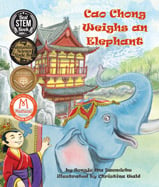Alignment to CORE and NGSS Standards

| Grade | Number | Standard |
|---|---|---|
| 1 | K-4)8 | By exploring the relationships among science, technology, and society, students develop an understanding of past and present advances in science and technology and their impact. |
| 1 | RI.1.9 | Identify basic similarities in and differences between two texts on the same topic. (story versus For Creative Minds non-fiction component) |
| 1 | RL.1.5 | Explain major differences between books that tell stories and books that give information, (paired fiction & For Creative Minds non-fiction) |
| 2 | NGSS: 2-ETS1.A-1 | A situation that people want to change or create can be approached as a problem to be solved through engineering. (K-2-ETS1-1) |
| 2 | NGSS: 2-ETS1.A-2 | Asking questions, making observations, and gathering information are helpful in thinking about problems. (K-2-ETS1-1) |
| 2 | NGSS: 2-ETS1.A-3 | Before beginning to design a solution, it is important to clearly understand the problem. (K-2-ETS1-1) |
| 2 | RI.2.4 | Determine the meaning of words and phrases in a text relevant to a grade 2 topic or subject area: Earth processes: quickly/slowly, wind/water shape land, plate tectonics, maps, water: ocean/rivers/lakes-solid or liquid, STEM: drawings, plant basic needs, seed dispersal, biodiversity, state of matter: solid/liquid, small objects make larger, heating/cooling substance causes observable change, add/subtract 100-20 mentally, equal groups for multiplication foundation, odd/even numbers, place value 3 digits, skip counting, measure length using 2 different measurements (inches/feet/yard/cm/m), compare objects by measurement, number line, time to 5 minutes, money/currency, line plot, picture graph, bar graph 4 categories, shapes/angles/number faces, divide shapes into halves, thirds, quarters, fables/folktales from diverse cultures, rhyme and rhythm, compare two/more versions same story, collective nouns |
| 2 | RI.2.9 | Compare and contrast the most important points presented by two texts on the same topic. (story versus For Creative Minds non-fiction component) |
| 2 | RL.2.3 | Describe how characters in a story respond to major events and challenges. |
| 3 | 3.MD.A.2 | Measure and estimate liquid volumes and masses of objects using standard units of grams (g), kilograms (kg), and liters (l).1 Add, subtract, multiply, or divide to solve one-step word problems involving masses or volumes that are given in the same units, e.g., by using drawings (such as a beaker with a measurement scale) to represent the problem.2 |
| 3 | L.3.6 | Acquire and use accurately grade-appropriate domain-specific words and phrases: Weather prediction, weather versus climate, natural hazards, life cycles, changing environments: organisms survive/move/adapt/die, animal group behavior, inherited traits, instinct/learned behavior, extinct animals, fossils, individual advantages survival/mating, habitat survival: physical/behavioral adaptations, living things change habitats, force/motion: strength/direction/electric/magnetic, multiplication/division, unknown number m/d equation, m/d fact families, two-step word problems, place value rounding, fractions, time to minute, liquid volumes, scaled picture graph/bar graph, measurements to fractional inches, line plot, area, square units, area=multiplication/division, perimeter, shapes in different categories (rhombus/rectangle=quadrilateral), divide shapes by equal area, fables/folktales/myths from diverse cultures, compare/contrast stories from same author/series, |
| 3 | RI.3.9 | Compare and contrast the most important points and key details presented in two texts on the same topic. (story versus For Creative Minds non-fiction component) |
| 4 | 4.MD.A.1 | Know relative sizes of measurement units within one system of units including km, m, cm; kg, g; lb, oz.; l, ml; hr, min, sec. Within a single system of measurement, express measurements in a larger unit in terms of a smaller unit. Record measurement equivalents in a two-column table. For example, know that 1 ft is 12 times as long as 1 in. Express the length of a 4 ft snake as 48 in. Generate a conversion table for feet and inches listing the number pairs (1, 12), (2, 24), (3, 36), ... |
| 4 | NGSS: 4-ETS.1.C | Different solutions need to be tested in order to determine which of them best solves the problem, given the criteria and the constraints. (secondary to 4-PS4-3) |
| 5 | RI.5.5 | Compare and contrast the overall structure (e.g., chronology, comparison, cause/effect, problem/solution) of events, ideas, concepts, or information in two or more texts. (Paired reading-story versus For Creative Minds non-fiction component) |
| K | K.MD.A.1 | Describe measurable attributes of objects, such as length or weight. Describe several measurable attributes of a single object. |
| K | NGSS: K-ETS1.A | Asking questions, making observations, and gathering information are helpful in thinking about problems. (secondary to K-ESS3-2) |
| K | NGSS: K-ETS1.A | A situation that people want to change or create can be approached as a problem to be solved through engineering. Such problems may have many acceptable solutions. (secondary to K-PS2-2) |
| K | RI.K.9 | With prompting and support, identify basic similarities in and differences between two texts on the same topic. (comparing story to For Creative Minds non-fiction component) |
| K-4 | K-4)2.8A | The student understands the development of technological innovations, the major scientists and inventors associated with them and their social and economic effects |
| K-4 | K-4)3.10.1 | A culture has distinctive characteristics |
| K-5 | Dewey | [E] |